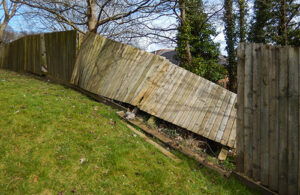Fence is a wall or barrier of wood, masonry, rails, or panels to enclose property or secure parcels of land. Some damage to fences requires only minor repairs, but others can be serious enough that the entire structure needs replacement.
Make sure you’re actually building on your own land before starting any fence repair work by checking a property survey.
A fence’s posts hold the panels up, but if they shift or lean, it can be a safety issue. Whether the post rotates at the base or the concrete footer has broken, you can correct the problem by digging out the old post, making a new footing, and cementing it. If several posts are showing signs of shifting, it may be time to consider replacing the entire fence.
A lot of times, fence posts will start to lean for no obvious reason. It could be due to the soil settling unevenly, or it might be that one side of the fence has been hit with a physical blow. If you can see damage to the posts at the base, it’s likely they cannot be saved, but a metal or wooden post in concrete shouldn’t move easily, so that’s usually an indication that it can be straightened.
If your fence is made of wood, you can try to save a sagging post by using wooden braces to keep it in place until you can dig out and replace the post. You can also try using a metal fence stay, which acts like a brace for the post and gives it some extra support. Metal stays come in various sizes and shapes, so you can choose the best one for your situation.
Before starting to dig up a post that’s leaning, call 811. This is the national “call before you dig” number and will help identify any underground utility lines in the area. You may want to contact your neighbors as well, since fences often straddle property lines.
Dig out the old post, then dig a hole at the proper depth for a new footing. Use a level to make sure the new footing is aligned with the other posts and then pour it in place. Adding a gravel mixture to the footing will help ensure that it drains properly and won’t settle. After you have your new footing in place, nail or screw the post to it and reattach any fence panels that were removed.
Falling Panels
When a panel falls off a high building it poses a major safety threat. A person leaning on a dislodged panel could fall off the building and hurt or even kill themselves. Also, the hole left behind by a falling panel could be a dangerous tripping hazard for building residents.
MBTA Interim General Manager Jeff Gonneville said that this particular panel fell because of corrosion on the supports. He did acknowledge that the cladding system at this station is decorative and hangs from the ceiling of the actual train tunnel and that inspectors might not have been able to see the problem area clearly.
It is not clear what caused this failure but it appears that the slotted holes for the fixings on the panels were too close to the edge of the panel. Thin sheeting such as this has very little inertia and almost no structural damping and can vibrate. This vibration can induce dynamic effects that the panels and their fixings were not designed to accommodate. Fatigue due to gust buffeting might have played a part in this failure as well. In any event the fact that this type of panel could fail based on simple mechanical forces should raise questions about the design, manufacture and installation of similar cladding systems on other buildings.
Insect Infestation
Taking steps to prevent pest infestations is the best way to ensure that your property is safe and secure. In addition to causing damage, some types of insects can also carry disease and pose health risks. Pests can be difficult to spot until they’ve already caused damage and need to be eliminated, but if you know what to look for, you can take action to keep them from damaging your property or harming your family’s health.
Many people associate pests with filthy living areas, but this isn’t always the case. In fact, most pests enter homes in search of warmth and shelter as the weather turns cold. Some pests will also seek out places where they can find food, water and protection from predators.
Pests can cause a wide range of damage to buildings, including structural damage, water and air quality problems, health hazards for building occupants, and a decrease in property value. Pests can also be a significant nuisance for building occupants, leading to lost productivity and discomfort.
The best way to prevent pests is through regular maintenance, which can include cleaning, repairing, sealing and caulking cracks around your home. Trimming bushes and clearing away debris from the exterior of your home can help to limit insect access as well. In addition, you should install screens on windows that open so that bugs aren’t able to crawl inside. Finally, you can reduce the risk of pests entering your home by sealing any gaps or cracks around vents or in the foundation.
Some pests can be controlled with simple steps, while others will require professional treatment and extermination. For example, a few seasons of fruit flies aren’t a problem, but an infestation of termites will need to be addressed by a pest control expert.
If you do notice signs of a pest problem, it is important to act quickly. Early detection is key to preventing extensive damage and reducing the cost of pest control measures. Signs of pest activity include the presence of live or dead insects; insect parts such as wings, carcasses, frass and droppings; and damaged areas on a building or artifact including scabs, perforated skins and feathers, grazed nap, decay and mold.
